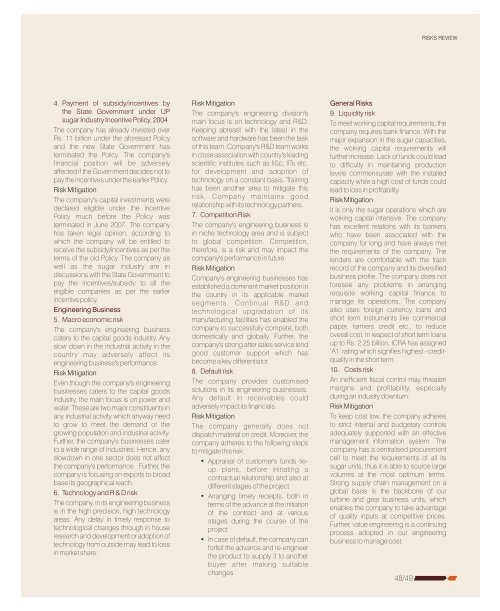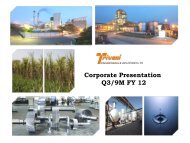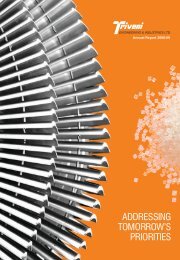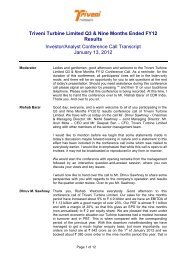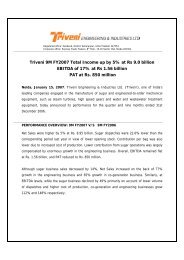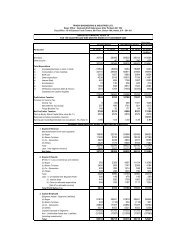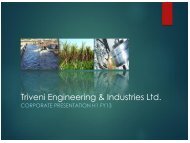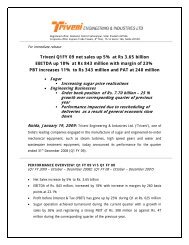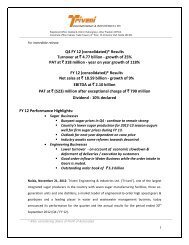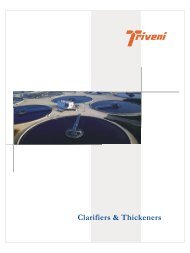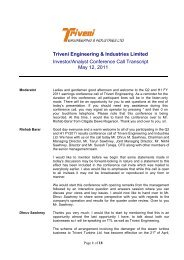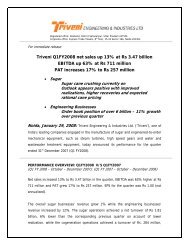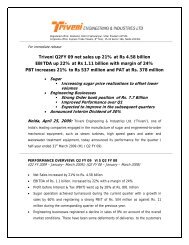Introduction - Corporate Governance - Triveni Engineering
Introduction - Corporate Governance - Triveni Engineering
Introduction - Corporate Governance - Triveni Engineering
You also want an ePaper? Increase the reach of your titles
YUMPU automatically turns print PDFs into web optimized ePapers that Google loves.
RISKS REVIEW<br />
4. Payment of subsidy/incentives by<br />
the State Government under UP<br />
sugar Industry Incentive Policy, 2004<br />
The company has already invested over<br />
Rs. 11 billion under the aforesaid Policy<br />
and the new State Government has<br />
terminated the Policy. The company's<br />
financial position will be adversely<br />
affected if the Government decides not to<br />
pay the incentives under the earlier Policy.<br />
Risk Mitigation<br />
The company's capital investments were<br />
declared eligible under the Incentive<br />
Policy much before the Policy was<br />
terminated in June 2007. The company<br />
has taken legal opinion, according to<br />
which the company will be entitled to<br />
receive the subsidy/incentives as per the<br />
terms of the old Policy. The company as<br />
well as the sugar industry are in<br />
discussions with the State Government to<br />
pay the incentives/subsidy to all the<br />
eligible companies as per the earlier<br />
incentive policy.<br />
<strong>Engineering</strong> Business<br />
5. Macro economic risk<br />
The company's engineering business<br />
caters to the capital goods industry. Any<br />
slow down in the industrial activity in the<br />
country may adversely affect its<br />
engineering business's performance.<br />
Risk Mitigation<br />
Even though the company's engineering<br />
businesses caters to the capital goods<br />
industry, the main focus is on power and<br />
water. These are two major constituents in<br />
any industrial activity which anyway need<br />
to grow to meet the demand of the<br />
growing population and industrial activity.<br />
Further, the company's businesses cater<br />
to a wide range of industries. Hence, any<br />
slowdown in one sector does not affect<br />
the company's performance. Further, the<br />
company is focusing on exports to broad<br />
base its geographical reach.<br />
6. Technology and R & D risk<br />
The company, in its engineering business<br />
is in the high precision, high technology<br />
areas. Any delay in timely response to<br />
technological changes through in house<br />
research and development or adoption of<br />
technology from outside may lead to loss<br />
in market share.<br />
Risk Mitigation<br />
The company's engineering division's<br />
main focus is on technology and R&D.<br />
Keeping abreast with the latest in the<br />
software and hardware has been the task<br />
of this team. Company's R&D team works<br />
in close association with country's leading<br />
scientific institutes such as IISc, IITs etc.<br />
for development and adoption of<br />
technology on a constant basis. Training<br />
has been another area to mitigate this<br />
risk. Company maintains good<br />
relationship with its technology partners.<br />
7. Competition Risk<br />
The company's engineering business is<br />
in niche technology area and is subject<br />
to global competition. Competition,<br />
therefore, is a risk and may impact the<br />
company's performance in future.<br />
Risk Mitigation<br />
Company's engineering businesses has<br />
established a dominant market position in<br />
the country in its applicable market<br />
segments. Continual R&D and<br />
technological upgradation of its<br />
manufacturing facilities has enabled the<br />
company to successfully compete, both<br />
domestically and globally. Further, the<br />
company's strong after sales service lend<br />
good customer support which has<br />
become a key differentiator.<br />
8. Default risk<br />
The company provides customised<br />
solutions in its engineering businesses.<br />
Any default in receivables could<br />
adversely impact its financials.<br />
Risk Mitigation<br />
The company generally does not<br />
dispatch material on credit. Moreover, the<br />
company adheres to the following steps<br />
to mitigate this risk:<br />
• Appraisal of customer's funds tieup<br />
plans, before initiating a<br />
contractual relationship and also at<br />
different stages of the project<br />
• Arranging timely receipts, both in<br />
terms of the advance at the initiation<br />
of the contract and at various<br />
stages during the course of the<br />
project<br />
• In case of default, the company can<br />
forfeit the advance and re-engineer<br />
the product to supply it to another<br />
buyer after making suitable<br />
changes<br />
General Risks<br />
9. Liquidity risk<br />
To meet working capital requirements, the<br />
company requires bank finance. With the<br />
major expansion in the sugar capacities,<br />
the working capital requirements will<br />
further increase. Lack of funds could lead<br />
to difficulty in maintaining production<br />
levels commensurate with the installed<br />
capacity while a high cost of funds could<br />
lead to loss in profitability.<br />
Risk Mitigation<br />
It is only the sugar operations which are<br />
working capital intensive. The company<br />
has excellent relations with its bankers<br />
who have been associated with the<br />
company for long and have always met<br />
the requirements of the company. The<br />
lenders are comfortable with the track<br />
record of the company and its diversified<br />
business profile. The company does not<br />
foresee any problems in arranging<br />
requisite working capital finance to<br />
manage its operations. The company<br />
also uses foreign currency loans and<br />
short term instruments like commercial<br />
paper, farmers credit etc., to reduce<br />
overall cost. In respect of short term loans<br />
up to Rs. 2.25 billion, ICRA has assigned<br />
‘A1’ rating which signifies highest –creditquality<br />
in the short term.<br />
10. Costs risk<br />
An inefficient fiscal control may threaten<br />
margins and profitability, especially<br />
during an industry downturn.<br />
Risk Mitigation<br />
To keep cost low, the company adheres<br />
to strict internal and budgetary controls<br />
adequately supported with an effective<br />
management information system. The<br />
company has a centralised procurement<br />
cell to meet the requirements of all its<br />
sugar units, thus it is able to source large<br />
volumes at the most optimum terms.<br />
Strong supply chain management on a<br />
global basis is the backbone of our<br />
turbine and gear business units, which<br />
enables the company to take advantage<br />
of quality inputs at competitive prices.<br />
Further, value engineering is a continuing<br />
process adopted in our engineering<br />
business to manage cost.<br />
48/49


